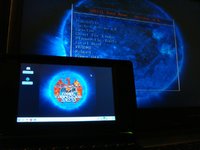No direct work on it today, as i'm on the next Slackware release.
I included in it the firewall/router scripts, and i've also compiled custom kernels that got all modules needed for that purpose. As this can be also used in bare SL4P, there is no point including it only in SOLEIL.
One of those kernels is non-debug, that means i removed many unnecessary features for better performance, and will be used as default for SOLEIL.
I'm also working on a new secret kinda killer feature, but it should work only on x86_64 clients, at least for now.
Don't remember if i already mentioned it, but the OP now acts as a DHCP (of course: PXE already works), DNS and NTP server for the sub network.
As a standard, i will make eth1 the internet interface, and eth0 the LAN one.
Of course, it will be possible to use wlan0 as the internet, but there is no pre-setup for now.
Once i got a new full image, i'll make a video.


